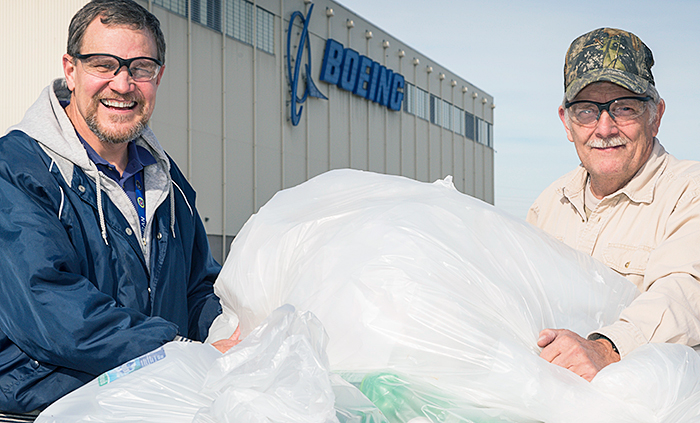Green Team harnesses the power of one

Material handling specialists Ricky Rhine (left) and Clayton Maxwell collect a portion of the 4,000 pounds of bubble wrap recycled each month at Boeing St. Louis. Recycling has helped the site reduce by two-thirds the amount of waste it sends to landfills annually. (Boeing photo)
Cheryl Fievet remembers the early days of recycling at Boeing’s St. Louis site and sometimes has a hard time believing how far the recycling program has come in the past 10 years.
“We started in 2003 with a handful of employees pushing to recycle the plastic soda pop bottles from vending machines. We thought it was a big step forward just being allowed to move recycling containers indoors from outside in the parking lots,” said Fievet, an industrial engineer.
Through persistence, partnerships with the site’s facilities group and support from leadership, the “handful” of employees a decade later is now the Boeing Employees for Environmental Protection, or BEEP, with 250 members. It’s one of the largest teams of environmentally active employees at Boeing.
The St. Louis team is credited with helping establish innovative recycling projects that have helped Boeing reduce its environmental footprint and expand opportunities for employees to recycle and get involved with a variety of environmental activities.
Facilities manager Bryan Kury said employee engagement plays an important role in helping Boeing continue to improve its environmental performance. “It’s all about harnessing the power of the engaged and informed employee,” he said.
The success of the employees’ efforts can be measured in part by the amount of solid waste the site now recycles; up from 12 percent in 2007 to 67 percent in 2012. The volume of waste sent to landfills has been reduced by two-thirds. Across the company, almost 80 percent of the solid waste Boeing generated from 2007 to 2012 was diverted from landfills.
The initial push in St. Louis to recycle beverage containers expanded to include other materials, including cardboard, paper, wood, empty paint and sealant containers, Styrofoam, and several types of plastic. About 4,000 pounds (1,800 kilograms) of bubble wrap is recycled each month alone.
The strong interest in recycling enables the St. Louis team to organize on-site events during which employees can bring from home used electronics and other household items that are donated to community groups for reuse or recycling. Athletic shoes are donated to Nike for recycling into a surface material used on playgrounds and athletic fields; blankets and towels are given to a local animal shelter.
In addition to a monthly newsletter, the team has an internal website and a network of “champions” in nearly every building who monitor recycling containers and serve as employee contacts. But good communications is only one part of the picture, said Alyssa Duarte-Reinagel, a systems manager who helped launch the site’s broader recycling efforts in 2003.
“You need to come with ideas, suggestions and solutions for what needs to be done; you can’t just complain about something,” Duarte-Reinagel said.
She and other team members say BEEP is an example of how one employee, with persistence and commitment, can make a difference.
“When I hear people say, ‘We can’t change things,’” Duarte-Reinagel said, “I point to the blue recycling containers all around the site and say, ‘Actually, you can.’”

